| A mountainside of dramatic peaks, valleys and ravines ranging from 1500 to 4500 feet above sea level, laced together with picturesque streams and waterfalls. For a holiday with a difference, try this secluded green enclave. For KL residents the place is easily accessible and driving is a breeze via the Karak Highway.  Janda Baik is set amidst a small valley bounded by thick rainforest with cool rushing brooks and waterfalls. Located approximately 30km and about an hour’s drive from Kuala Lumpur, the place is a popular holiday and recreational destination for city folks. Located somewhere between the towering hills of Genting Highlands and the Berjaya Hills Resort, it is no surprise that the place is much cooler at between 23° and 28°Celsius during the day and below 22°Celsius in the evenings. Janda Baik is set amidst a small valley bounded by thick rainforest with cool rushing brooks and waterfalls. Located approximately 30km and about an hour’s drive from Kuala Lumpur, the place is a popular holiday and recreational destination for city folks. Located somewhere between the towering hills of Genting Highlands and the Berjaya Hills Resort, it is no surprise that the place is much cooler at between 23° and 28°Celsius during the day and below 22°Celsius in the evenings."Janda Baik" means "the good widow" in Malay. In the old days a path that connected Selangor and Pahang cuts through the village. A warrior, who was returning after fighting in a civil war in Selangor, stopped at the village for a rest and to nurse some wounds he sustained in battle.  Upon seeing this ragtag team in the vicinity, a kindly widow immediately offered help and tended to the warrior's wounds. The man was thankful and deeply cherished the kindness. As a mark of respect for this kind widow, the he would always remind his men to call on the woman whenever they were in the vicinity. Fast forward to the present: Today, almost all the resorts and camps in Janda Baik offer motivational courses, as well as various obstacle challenges such as the ever popular jungle trekking, flying fox and abseiling. Camping grounds are also available. Upon seeing this ragtag team in the vicinity, a kindly widow immediately offered help and tended to the warrior's wounds. The man was thankful and deeply cherished the kindness. As a mark of respect for this kind widow, the he would always remind his men to call on the woman whenever they were in the vicinity. Fast forward to the present: Today, almost all the resorts and camps in Janda Baik offer motivational courses, as well as various obstacle challenges such as the ever popular jungle trekking, flying fox and abseiling. Camping grounds are also available. | ||||||
|
Sunday, October 31, 2010
Janda Baik - Nice Widow
Kuala Gandah
| |
 The Kuala Gandah Elephant Conservation Centre (coordinates: 3˚ 35'34.4”N and 102˚ 08'37.7”E) is essentially a sanctuary for orphaned elephants found in Malaysia. Situated within the bio-diversified wilds of the Krau Game Reserve, the centre was set-up in 1989 under the Department of Wildlife & National Parks, Malaysia. This unit is one of its kind in the world where the possibilities of being charged or trampled by enraged wild elephants happens for two weeks every month! It is a thankless job where initially only a very tiny percentage of the general public is aware of the existence, dedication and sacrifices these dedicated men and women make to provide a win-win situation for both the wild elephants and the planters! There are 24 full time and 6 contracted staff working and living in and near the centre. Please be informed that 'fun' activities, including elephant rides at the sanctuary is not the main factor in the establishment of the place. It is to add value to the place now that it is known far and wide as a must visit site among tourists to view this species of gentle pachyderms. Frankly, it quite pains the heart to see them having to carry load after loads of shrieking visitors on their back. |
| GETTING THERE : | |
| From Kuala Lumpur, take the Karak Highway to Lanchang, passing Karak along the way. At Lanchang, turn left into the road just before the BP station, then follow the ample direction signage towards the Elephant Sanctuary. You will pass by an Orang Asli settlement before reaching the Kuala Gandah Elephant Sanctuary. The journey takes about 2 to 2 ½ hours (roughly 160km from Kuala Lumpur). | |
| OPENING HOURS : | |
| The centre is open from 8.00 p.m. to 4.30 p.m. daily but activities mostly begin from 2.00 p.m. onwards. Entrance is free. Please be reminded that despite some advise from certain quarters (websites notwithstanding) that the centre needs donations from visitors, this is not necessary as the centre has ample financial allocations for its upkeep. The centre can get busy during the weekends, so it it would be better for you to visit it on weekdays. Note: Please come early because if the quota for elephant ride is full (120 persons per day), you may be issued with a red pass instead of the coveted yellow pass, which only allows for viewing, hence, no elephant rides. | |
| FACILITIES : | |
| A visitor information centre provides information and video presentation on the centre's elephant conservation efforts. Visitors can participate in daily activities, like feeding and grooming the elephants and helping with the bathing of each animal in the nearby stream. There is no accommodation at the centre but you may want to stay overnight at Temerloh or Mentakab. | |
| ACTIVITIES : | |
| In the morning, visitors can view the exhibition and a video presentation on elephant translocation before proceeding to watch the elephants in their enclosure. Elephant feeding, rides and bathing start after 2 p.m. There is a small warung (cafe) run by a local where you can get drinks and local food. Public toilets and showers for those who want to have a wash after bathing in the river with the elephants. Food to feed the elephants is provided so there is no need to bring any of your own. | |
| CONTACT : | |
| Kuala Gandah Elephant Conservation Centre, Jabatan PERHILITAN Kuala Gandah 28500 Lanchang Pahang Darul Makmur, Malaysia Tel : 09-279 0391 Email: necc@wildlife.gov.my | Office hours: Monday – Sunday: 8.00 a.m. - 1.00 p.m. 2.30 p.m. - 4.30 p.m. Friday: |
Lake Bera
| | ||||||||||||||||||||||||||
| As Malaysia's largest natural lake, Tasik Bera is important for its biodiversity. Seasonal and shallow, this riverine lake system is home to about 100 fish species, approximately 200 bird species; and several endangered reptiles such as the Malayan False Gharial (a freshwater, fish-eating crocodile), the Striped Giant Soft-Shelled Turtle, the much sought after Malayan Giant Turtle, reticulated pythons that can grow to a length of 18 feet, prehistoric looking monitor lizards and lots of frogs species, including the great Malaysian frog that can weigh-in as heavy as 2kg. Tasik Bera is still the mysterious and unique remote wetland wilderness it has been made out to be through the millennia. Surrounded by a scattering of dry lowland dipterocarp forests, the lake environment projects deep into the peat swamp forests. With abundant wildlife and vegetation (there are 19 types of plants that cannot be found elsewhere in Malaysia), the wetlands is an ecosystem which supports not only a diversity of animal and plant life, but also the livelihood of the Semelai, the aboriginal people that inhabits the area. This wetland plays an important role in flood control. The water flow regulation and purification provides many natural resources for the local community. For this reason it is protected under the RAMSAR CONVENTION -- an international treaty, which allows for traditional and prudent use. Since November 1994, the Tasik Bera wetlands, including the core zone of 26,000 hectares and a buffer zone of 27, 500 hectares, area has been declared a Ramsar site. The Seasons at Tasik BeraWatch out carefully for the seasons at Tasik Bera. The rainy period isf rom April to May and from September to January while the dry periods are from February to April and June to August. For fishing, go by what the Semelai say: the best times are after heavy rain. However, there may be a trade-off here as the rainy months may cause some of the best spots to be quite inaccessible. The Wildlife of Tasik Bera | ||||||||||||||||||||||||||
| LOCATION : | |
| Southwest Pahang. | |
| GETTING THERE : | |
| Due to the vastness of the area, there are several ways to get to Tasik Bera. The easiest route from Kuala Lumpur follows the Karak Highway to Temerloh and then south towards the town of Triang, where signboards, just before Kerayong, will lead you to the north side jetties and tourism complex. A second route goes through Seremban, Kuala Pilah and Bahau in Negeri Sembilan and then heads north to Triang. Entering from the south end of the lake, an alternative route leads from Bahau to Ayer Hitam and then east towards Muadzam Shah. Look out for a turnoff signpost to Tasik Bera, which leads up the eastern side of the wetland and to the tourism complex. Travelling time from Kuala Lumpur is 3 ½ to 4 hours. Visitors can also take the train from both Kuala Lumpur and Singapore. Trains stop in Triang and Mentakab, where taxis are available to take you to the Bera jetty, about 45 and 60 minutes respectively. Although buses can be taken to both Triang and Mentakab, as well as to Temerloh, there are no such services to Tasik Bera, making it necessary to hire a taxi. There are no local car hire facilities, so cars must be hired in Kuala Lumpur or Kuantan. | |
| ACTIVITIES : | |
| Jungle-trekking Exploration and jungle trekking -- that's the best thing to do here. Engage an experienced guide to take you through the wild and verdant labyrinth that is the lake area. You will be introduced to many things, from identifying the tracks of wild animals such as tiger, wild boar, sun bear, leopard, and mouse deer to interesting flora. Canoeing Fishing | |
| ACCOMMODATION : | |
| Although there are quite a number of operators for tours to Tasik Bera, I would recommend that you get some advice from the Malaysian Chapter of Wetlands International. Tel: +603 7804 6770 or SABOT (Semelai Association for Boat and Tourism), which is fully owned and managed by the Semelais. They can arrange overnight trips to the jungle and swamp. You will stay at isolated jungle/lake campsites with only very simple facilities to experience a close encounter with the swamp and jungle. SABOT's campsites at Tasik Bera are:
| |
| Kampung Chenderung Jungle Camp Suitable for the more adventurous. This campsite is located near several challenging jungle trails that traverse the forest. The short trails will take one to two hours to complete. Longer trails can last from three to five hours. | Kampung Sembilan Campsite With a beautiful lakefront view and picture-perfect scenery, Kampung Sembilan is strategically located for campers. Toilets, bathing and cooking facilities. Stay in a Semelai house, which can accommodate 35 people at a time. |
| Kampung Dato Campsite The Kampung Dato campsite, which can house 20 people at a time provides you with many opportunities to meet the Semelais. Located near the cultural village of Kampung Jelawat, which is home to many musicians and skilled craftsmen, the village remains largely untouched by modernisation. | Kampung Mikok Campsite Just 3-minutes walk from the lake front, Kampung Mikok is strategically located at the midway point of Tasik Bera waterway. Ideal for 20 people, this campsite is also equipped with a traditional house and basic amenities. Observe the many different types of aquatic plants and habitats here. |
| CONTACT : | |
| Wetlands International – Malaysia, 3A39, Block A, Kelana Centre Point Jalan SS17/19, Petaling Jaya 47301 Selangor, MALAYSIA. | Tel: +603 7804 6770 Fax: +603 7804 6772 Email: malaysia@wetlands.org.my |
| Photo credits: Semelai handicrafts, Wetlands International | |
Lake Chini
| | ||||||||||||||||||||
| Colourful and intriguing, but the pristine nature of this ancient body of water begs certain questions to be answered in terms of ecological management and the protection of the enclave's delicate ecosystem. Myths and Legends One facet of the legend tells of the story of a nomadic group of Jakun who were clearing the jungle to grow food crops. As they were working, an old woman suddenly appeared, claiming that she was the owner of the land and that whoever wished to clear the For want of a logical explanation, the group of Jakuns concluded that the log was actually the manifestation of the dragon, Naga Seri Gumum. Through the years, much has been said about the mysteries and magic of the lake and its environs. Besides the belief that deep beneath the dark waters of the lake lurks a monster, people also talk about a sunken Khmer city that had at one time existed in the area. Several years back, an archaeological expedition was mounted to study the area but results are still wanting. AccommodationDecent and comfortable accommodation is available at the park. Reasonably-priced chalets take the work out of looking for a suitable place to spend the nights. For the more adventurous, you can rough it out at the designated camping sites. Over in the town of Temerloh there are hotels, lodges, inns and a rest house. For list of accommodation please click here.
| ||||||||||||||||||||
Saturday, August 14, 2010
Gunung Senyum of Malaysia
Gunung Senyum is on the left and Gunung Jebak Puyuh is on the right
Check out the number of caves to explore. I only covered approx 18 caves.

Gunung Senyum at the break of dawn
Can’t remember what cave this was…
Looks like a painting, doesn’t it?
In awe of the view

Surrealism

Batman?
The light peering through

| How To Get There |
|  |
| | Contact |
| Pejabat Hutan Daerah Temerloh [Forest Department of Temerloh] Tel: 609-2962755 Fax: 609-296239 |
Friday, August 13, 2010
Tasik Chini rebirth of the sacred lotus
The lake, with the mountain of Gunung Chini
in the background.

Tucked away in a quiet corner of the Malaysian state of Pahang lies the legendary lake of Tasik Chini. The ancient legends of this enchanting lake involve tales of sorcery and dragons, but the modern saga of this wetland is one of ecological mismanagement and the near collapse of a delicate ecosystem. Hopefully, it looks like the story may have a happy ending.
Myths and Legends
Local legend tells a tale of a wandering group of Jakun tribesmen who cleared the land to grow food crops. During their labour, an old woman appeared who proclaimed that she was the rightful owner of the land and that her permission should have been sought before any trees were felled. The Jakun humbly apologised, whereupon the woman allowed the men to continue their work. Before departing, however, she planted her walking stick in the ground as a mark of her ownership, telling the men never to remove it.
Beautiful sunsets are common.

The men continued with their work, but some time later they heard one of their dogs barking and snarling at a decaying log. One of the Jakun threw his stick at the log, but immediately a torrent of blood issued from the log causing the man to run back to his friends in fear. His friends thought he was possessed by demons and tried to keep away from him. However, the barking continued so the entire tribe returned to investigate the log. A spreading pool of blood had formed around the log.
In fear they hurled their own sticks at the sight, whereupon a dark cloud gathered in the sky. The thunder roared, the lightning flashed and a torrent of rain fell from the sky. The men grabbed their belongings and ran for cover, but in the chaos one of them pulled the old woman's stick from the ground - the very stick which they had been warned not to touch. Immediately a fountain of water poured from the hole made by the stick. The water flowed for many years, thereby creating the lake of Tasik Chini. The tribe realised then that the log was actually the dragon called Naga Seri Gumum.
Of course, no magical lake would be complete without stories of a resident monster or a long-lost, sunken city. So, Tasik Chini has both ! Much like the famous Loch Ness, a serpent-like monster is reputed to make the lake its home. More seriously, there are theories that an ancient Khmer city once existed in the vicinity which has prompted archaeological studies of the lake and its surrounds.
The Sacred Lotus
Flower and receptacle of the Sacred Lotus Nelumbo nucifera

In reality, Tasik Chini is less a lake and more a naturally dammed tributary of the mighty Pahang River, which lies to the north. Until recently the lake's waters rose and fell with the seasons - during the rainy season the waters were unable to flow down the narrow Sungai Chini and so became backed up in a series of lakes. A unique ecosystem developed, dominated by the presence of the Sacred Lotus Nelumbo nucifera which once covered the entire surface of the lake system.
During low waters the lotus seeds would germinate, the roots would take hold in the soft mud and the stunning blooms would appear on the water's surface. During monsoonal floods, from October to January the lotus would die back but, the flowers having been fertlised, new seeds would litter the lake bottom awaiting the dry season.

This lotus receptacle contains 31 edible seed-like fruits
Foolishly, in 1995 the State Government Of Pahang, in a bid to make the lakes more appealing to visitors in the dry season, built a dam at the point where the Sungai Chini enters the Pahang River. The waters were then never able to recede again. It wasn't long before the ecosystem started showing signs of stress.
The lotuses became fewer and fewer with the passing years, and large stands of various species of Eugenia trees which border the lake also died back, being unable to tolerate constant submergence. Happily, the mistake has been rectified; in early 2000 the dam was breached and redesigned to accommodate the annual rise and fall of the waters. The lotuses are returning once again, however it will be decades before the damage to the Eugenia is healed.
Local Wildlife
Dieback of Eugenia sp - due to
lake level mismanagement

The lake area comprises over 200 hectares of open water, and 700 hectares of freshwater swamp and swamp forest. In addition to the abundant lotuses, thickets of Pandanus helicopus or Rasau are common towards the margins, along with occasional water lilies. Encounters with turtles are common including the Malayan Soft Shelled Turtle Amyda cartilaginea and Spiny Terrapin Heosemys spinosa.
The surrounding forests are also rich in wildlife. In the dipterocarp forest primates such as the Banded Langur Presbytis melalophos, the handsome White-handed Gibbon Hylobates Lar, the ubiquitous Long-tailed Macaque Macaca fascicularis and the Pig-tailed Macaque Macaca nemestrina may be encountered. The latter species is a common pet of the Jakun people, who still eke a living from the lake and its surroundings. The status of larger mammals in the area, such as Elephant, Tiger and Tapir is unclear.

The Pig-tailed Macaque
Macaca nemestrina - commonly kept as pets by the Jakun people.
Curiously the lake does not seem so attractive to bird life, however common forest-edge species such as bulbuls, orioles and bee-eaters are present, and various kingfishers may be seen, including the uncommon Blue-eared Kingfisher Alcedo meninting. Overhead the rare Grey-headed Fish Eagle Ichthyophaga ichthyaetus still circles.
The lake also serves as an important breeding ground for fish species which upon reaching adulthood then populate the Pahang River. Their migration is now largely unimpeded by the previously dammed mouth of the Sungai Chini.
Information : Visitor facilities : Most visitors will stay at the lakeside Rimba Resort (formerly Lake Chini Resort). The resort has ten standard chalets with ceiling fan, dormitory rooms and a campsite. The rooms are simple but adequate, but some are in need of renovation. The resort has an open-air restaurant looking over the lake - try some of the local freshwater fish dishes. Boat hire and taxi / van transfer are available from the resort.
Pantai Cenang Guides
Everything you Need to Know about Pantai Cenang
Pantai Cenang – Langkawi’s main vein – may not be as rowdy as the Las Vegas strip but it is Malaysia’s most developed west-coast beach; its shores are a gorgeous mix of white sand, crystalline turquoise-blue waters and verdant palms.
Crammed with mostly budget to mid-range hotels, Pantai Cenang – located 25 km west of Kuah – is also home to more than a few high-end resorts. When the sun goes down a peculiar jumble of backpackers, expats, Asian tourists and families throng the main road to eat, drink and window shop.
There are a multitude of restaurants along this thoroughfare that serve seafood, western fare and local favourites. Try the cool Red Tomato for a drink or dine at Orkid Ria and sample some of their giant tiger prawns.
During low season Pantai Cenang is relatively lifeless.
Cameron Highlands
Cameron Highlands is a well developed hill resort which is located in the state of Pahang in Peninsular malaysia. It was named after a British surveyor, William Cameron who discovered it in 1885 during a mapping expedition. Since 1920, the hill has undergone various development that makes what it is today - an excellent place for tourists to spend their holidays
Its temperature ranges from 10 °C to 25 °C hence a favourite place for one to escape the heat of the cities. One can easily take a slow drive up or down the highland depending on which route one takes and stop by the many strawberry farms, vegetable gardens, cactus gardens, bee farms and rose gardens. Buy some of the products that are sold as you visit the farms.
Tea Plantation
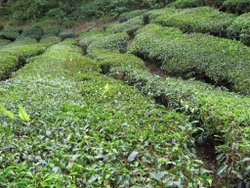 | A neatly planted
|
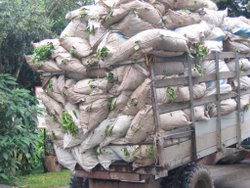 | Transporting tea leaves to the factor
|
Its attraction include the neatly planted tea plantations where one can go and see how the tea leaves are plucked and processed. The beautiful view overlooking the plantation is excellent for a picture album. The major ones that one can visit are the BHARAT tea plantation, BOH tea plantation and Blue Valley tea plantation. Visit any one of them and try the freshly brewed tea and enjoy the tranquility of the mountains. Among the 3 tea plantations, the one that is conveniently located beside the road is the BHARAT tea plantation. You will not miss it as it is located between the town of Habu and Tanah Rata.
Cactus Garden
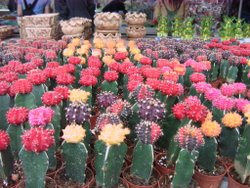 | Some of the cactus that are on sale
|
Bee Farm
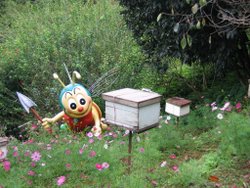 | Bee farm |
Brinchang Mountain
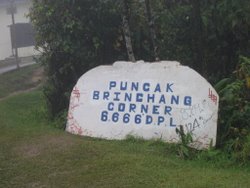 | Brinchang Mountain at |
Accommodation
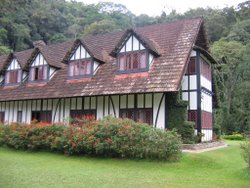 | The Tudor Style Lakehouse |
Personally, I would like to recommend The Lakehouse which was refurbished recently but still maintain its unique Tudor style. It has a big garden where one can sit and enjoy the mountainous scenery surrounding it. For those who is on a tighter budget, Rosa Pasadena is another reasonably priced hotel with basic amenities.
Getting To Cameron Highlands
If you are coming from the city of Kuala Lumpur, there are basically 2 ways to reach Cameron Highlands. The old and traditional way is driving through the narrow road via the town of Tapah. Though the journey up is winding, you will be able to see many beautiful plants that abound here.
The other easier way is using the NKVE Expressway and exit at Simpang Pulai instead of Tapah. The road from Simpang Pulai to Cameron is a new road which was opened to the public recently. It is wider and less winding compared to the traditional route. This route takes appoximately 51 km to reach Sungai Ikan.
If you are adventures, I would like to recommend that you go up using the traditional way via Tapah and coming back using the Simpang Pulai way. I can assure you that you will enjoy both of your trips.
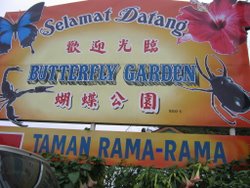 | Butterfly Garden |




 around the house to be readily used as medicines. This practice is still being observed to this day although the aboriginal outposts have medical clinic facilities at their disposal. With their deep understanding of the forest and lakes, the Semelais are always popular choice as guides. Traditional handicrafts made from material sourced from the wetland and forest such as coloured mats, miniature boats, fish traps, mouse deer traps, axes and other items are available for sale at Pos Iskandar.
around the house to be readily used as medicines. This practice is still being observed to this day although the aboriginal outposts have medical clinic facilities at their disposal. With their deep understanding of the forest and lakes, the Semelais are always popular choice as guides. Traditional handicrafts made from material sourced from the wetland and forest such as coloured mats, miniature boats, fish traps, mouse deer traps, axes and other items are available for sale at Pos Iskandar.

 area of the trees must obtain permission from her. Upon accepting the profound apologies of the wandering group, the old woman allowed them to continue with their task. However, before leaving, she struck her walking stick into the ground to stamp her ownership of this piece of real estate. She warned the group not to remove it - ever.
area of the trees must obtain permission from her. Upon accepting the profound apologies of the wandering group, the old woman allowed them to continue with their task. However, before leaving, she struck her walking stick into the ground to stamp her ownership of this piece of real estate. She warned the group not to remove it - ever.




